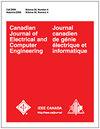Noncoherent Distributed Beamforming in Decentralized Two-Way Relay Networks
IF 1.7
Q2 Engineering
Canadian Journal of Electrical and Computer Engineering-Revue Canadienne De Genie Electrique et Informatique
Pub Date : 2020-09-09
DOI:10.1109/CJECE.2020.2991404
引用次数: 6
Abstract
Many noncoherent distributed strategies for cooperative sensor networks that do not require channel knowledge at any antenna to overcome the overhead involved in channel estimation are lately suggested; however, these strategies suffer from low system performance in terms of bit error rate (BER) and a comparably high decoding complexity. Differential beamforming strategies have recently been proposed to overcome these problems; however, they are implemented using the four-phase protocol. Thus, we propose a new strategy based on the three-phase protocol to increase the symbol rate. By doing this, a significant improvement can be achieved in the overall system performance. Hence, in this article, a new bidirectional differential beamforming strategy is suggested: 1) to be applied on the three-phase protocol instead of the four-phase protocol; 2) to be applicable for a decentralized wireless sensor network using single-antenna sensors distributed randomly between the communicating base stations; 3) to enjoy low decoding complexity; and 4) to improve the network performance in terms of BER by maximizing the received signal-to-noise ratio at the receiving base station without requiring channel knowledge at any antenna in the whole network. From our simulation results, the proposed strategy shows a substantially improved BER performance compared with the current state-of-the-art ones.分散双向中继网络中的非相干分布式波束形成
最近提出了用于协作传感器网络的许多非相干分布式策略,这些策略不需要任何天线处的信道知识来克服信道估计中涉及的开销;然而,这些策略在误码率(BER)方面的系统性能较低,并且解码复杂度相对较高。最近提出了差分波束形成策略来克服这些问题;然而,它们是使用四阶段协议来实现的。因此,我们提出了一种基于三相协议的新策略来提高符号率。通过这样做,可以在整个系统性能上实现显著的改进。因此,本文提出了一种新的双向差分波束形成策略:1)应用于三相协议而不是四相协议;2) 适用于使用随机分布在通信基站之间的单个天线传感器的分散式无线传感器网络;3) 以享受低解码复杂度;以及4)通过最大化接收基站处的接收信噪比来提高BER方面的网络性能,而不需要整个网络中的任何天线处的信道知识。从我们的仿真结果来看,与当前最先进的策略相比,所提出的策略显示出显著提高的BER性能。
本文章由计算机程序翻译,如有差异,请以英文原文为准。
求助全文
约1分钟内获得全文
求助全文
来源期刊

自引率
0.00%
发文量
27
期刊介绍:
The Canadian Journal of Electrical and Computer Engineering (ISSN-0840-8688), issued quarterly, has been publishing high-quality refereed scientific papers in all areas of electrical and computer engineering since 1976
 求助内容:
求助内容: 应助结果提醒方式:
应助结果提醒方式:


